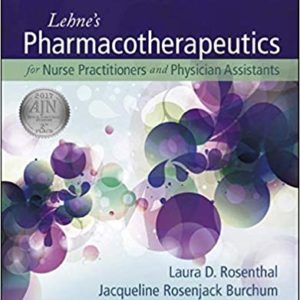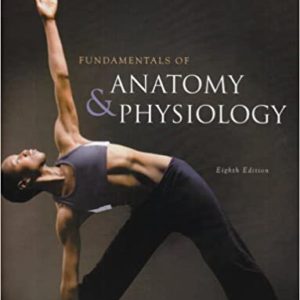Test Bank for Drugs Society and Criminal Justice 3rd Edition Charles F Levinthal
$35
Description
Test Bank for Drugs Society and Criminal Justice 3rd Edition Charles F Levinthal Test Bank
TABLE OF CONTENTS
Chapter 1 – Understanding Drug – taking Behavior [page 1 – page 14]
Chapter 2 – Understanding the Drug Problem in America [page 15 – page 28]
Chapter 3 – The History of Drug Use and Drug-Control Policy [page 29 – page 45]
Chapter 4 – Theoretical Perspectives on Drug Use and Abuse [page 46 – page 60]
Chapter 5 – Drugs and Crime [page 61 – page 76]
Chapter 6 – Drugs and the Criminal Justice System [page 77 – page 93]
Chapter 7 – Narcotics: Opium, Heroin, and Synthetic Opiates [page 94 – page 109]
Chapter 8 – The Major Stimulants: Cocaine and Amphetamines [page 110 – page 127]
Chapter 9 – LSD and Other Hallucinogens [page 128 – page 144]
Chapter 10 – Marijuana [page 145 – page 162]
Chapter 11 – Depressants and Inhalants [page 163 – page 179]
Chapter 12 – Performance-Enhancing Drugs and Drug Testing in Sports [page 180 – page 198]
Chapter 13 – Alcohol: Social Beverage/Social Drug [page 199 – page 218]
Chapter 14 – Chronic Alcohol Abuse and Alcoholism [page 219 – page 235]
Chapter 15 – Nicotine and Tobacco Use [page 236 – page 253]
Chapter 16 – Prevention and Treatment: Drug Policy and Intervention [page 254 – page 270]
CHAPTER 1
Understanding Drug-taking Behavior
Chapter 1 Multiple Choice
Select the correct answer. (Difficulty levels: Basic, Intermediate, Difficult)
1. According to the text, drugs such as alcohol and nicotine are referred to as:
a. illegal drugs
b. licit drugs
c. illicit drugs
d. over the counter drugs
Answer: b – licit drug
Objective: Basic terminology concerning drugs and drug taking behavior
Level: Basic
2. Instances in which a prescription or nonprescription drug is used in an inappropriate way
are regarded as:
a. illicit drug – taking behavior
b. illegal drug use
c. drug misuse
d. drug abuse
Answer: c – drug misuse
Objective: Basic terminology concerning drugs and drug taking behavior
Level: Basic
3. William is prescribed a drug from his doctor, and then prescribed a different drug from his
dentist. He did not tell either doctor about the other prescription. Unfortunately, when taken
together, drug one cancels out drug two, so the secondary drug has no effect. This type of drug
effect is:
a. sublingual
b. subtractive
c. synergistic
d. biotransformation
Answer: c. synergistic
Objective: The ways drugs enter and exit the body
Level: Intermediate
4. Which of the following forms of drug administration is the fastest?
a. intravenous
b. oral
c. intramuscular
d. sublingual
Answer: a – intravenous
Objective: The ways drugs enter and exit the body
Level: Basic
5. A transdermal patch works through the principle of what route of administration?
a. inhalation
b. oral absorption
c. absorption through the skin
d. absorption through the muscle
Answer: c – absorption through the skin
Objective: The ways drugs enter and exit the body
Level: Basic
6. What is the most common means of drug elimination through excretion?
a. urine
b. feces
c. saliva
d. breath
Answer: a – urine
Objective: The ways drugs enter and exit the body
Level: Basic
7. The rate of elimination of a particular drug can be determined by an index called:
a. the elimination quarter – life
b. the elimination rate – life
c. the elimination declination life
d. the elimination half – life
Answer: d – the elimination half – life
Objective: The ways drugs enter and exit the body
Level: Intermediate
8. When the combination of two drugs result in an acute effect that is equivalent to the sum of
the effects of either drug administered separately, the effect is known as:
a. subtractive
b. multiplicative
c. additive
d. obtuse
Answer: c – additive
Objective: Factors determining the physiological impact of drugs
Level: Intermediate
9. If there is a very strong effect when two drugs are taken in combination, even though
one of the drugs by itself has no effect and the other by itself has only a weak effect,
then what is the combination effect called?
a. additive
b. subtractive
c. synergistic
d. potentiation
Answer: d – potentiation
Objective: Factors determining the physiological impact of drugs
Level: Intermediate
10. The capacity of a drug dose to have a gradually diminished effect on the user as it is taken
repeatedly is known as:
a. drug interaction
b. drug dependence
c. drug tolerance
d. the placebo effect
Answer: c – drug tolerance
Objective: Factors determining the physiological impact of drugs
You must be logged in to post a review.




Reviews
There are no reviews yet.